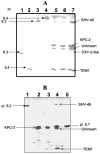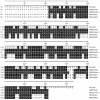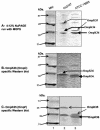Carbapenem-resistant strain of Klebsiella oxytoca harboring carbapenem-hydrolyzing beta-lactamase KPC-2
- PMID: 14638498
- PMCID: PMC296202
- DOI: 10.1128/AAC.47.12.3881-3889.2003
Carbapenem-resistant strain of Klebsiella oxytoca harboring carbapenem-hydrolyzing beta-lactamase KPC-2
Abstract
We investigated a Klebsiella oxytoca isolate demonstrating resistance to imipenem, meropenem, extended-spectrum cephalosporins, and aztreonam. The MICs of both imipenem and meropenem were 32 microg/ml. The beta-lactamase activity against imipenem and meropenem was inhibited in the presence of clavulanic acid. Isoelectric focusing studies demonstrated five beta-lactamases with pIs of 8.2 (SHV-46), 6.7 (KPC-2), 6.5 (unknown), 6.4 (probable OXY-2), and 5.4 (TEM-1). The presence of the bla(SHV) and bla(TEM) genes was confirmed by specific PCR assays and DNA sequence analysis. Transformation and conjugation studies with Escherichia coli showed that the beta-lactamase with a pI of 6.7, Klebsiella pneumoniae carbapenemase-2 (KPC-2), was encoded on an approximately 70-kb conjugative plasmid that also carried SHV-46, TEM-1, and the beta-lactamase with a pI of 6.5. The bla(KPC-2) determinant was cloned in E. coli and conferred resistance to imipenem, meropenem, extended-spectrum cephalosporins, and aztreonam. The amino acid sequence of KPC-2 showed a single amino acid difference, S174G, when compared with KPC-1, another carbapenem-hydrolyzing beta-lactamase from K. pneumoniae 1534. Hydrolysis studies showed that purified KPC-2 hydrolyzed not only carbapenems but also penicillins, cephalosporins, and aztreonam. KPC-2 had the highest affinity for meropenem. The kinetic studies revealed that KPC-2 was inhibited by clavulanic acid and tazobactam. An examination of the outer membrane proteins of the parent K. oxytoca strain demonstrated that it expressed detectable levels of OmpK36 (the homolog of OmpC) and a higher-molecular-weight OmpK35 (the homolog of OmpF). Thus, carbapenem resistance in K. oxytoca 3127 is due to production of the Bush group 2f, class A, carbapenem-hydrolyzing beta-lactamase KPC-2. This beta-lactamase is likely located on a transposon that is part of a conjugative plasmid and thus has a very high potential for dissemination.
Figures



References
-
- Archibald, L., L. Phillips, D. Monnet, J. E. McGowan, Jr., F. C. Tenover, and R. Gaynes. 1997. Antimicrobial resistance in isolates from inpatients and outpatients in the United States: increasing importance of the intensive care unit. Clin. Infect. Dis. 24:211-215. - PubMed
-
- Ardanuy, C., J. Linares, M. A. Dominguez, S. Hernandez-Alles, V. J. Benedi, and L. Martinez-Martinez. 1998. Outer membrane profiles of clonally related Klebsiella pneumoniae isolates from clinical samples and activities of cephalosporins and carbapenems. Antimicrob. Agents Chemother. 42:1636-1640. - PMC - PubMed
-
- Bingen, E. H., P. Desjardins, G. Arlet, F. Bourgeois, P. Mariani-Kurkdjian, N. Y. Lambert-Zechovsky, E. Denamur, A. Philippon, and J. Elion. 1993. Molecular epidemiology of plasmid spread among extended broad-spectrum β-lactamase-producing Klebsiella pneumoniae isolates in a pediatric hospital. J. Clin. Microbiol. 31:179-184. - PMC - PubMed
-
- Bradford, P. A., C. Urban, N. Mariano, S. J. Projan, J. J. Rahal, and K. Bush. 1997. Imipenem resistance in Klebsiella pneumoniae is associated with the combination of ACT-1, a plasmid-mediated AmpC β-lactamase, and the loss of an outer membrane protein. Antimicrob. Agents Chemother. 41:563-569. - PMC - PubMed
Publication types
MeSH terms
Substances
LinkOut - more resources
Full Text Sources
Other Literature Sources
Research Materials
Miscellaneous

